
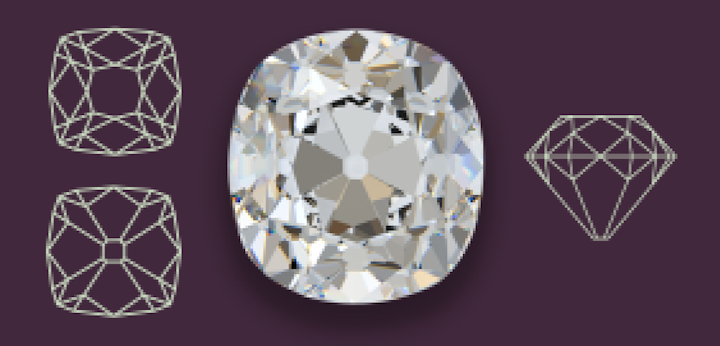
Old Mine Cut: A Guide to A Storied Diamond Shape
The Old Mine Cut is a historic diamond cut that was the most common diamond cut from the early 18th century to the late 19th century, which corresponds to the Georgian and Victorian era. During the height of the popularity of this engagement ring cut, diamonds were cut by hand and their measurements were eyeballed.
Old Mine Cut diamonds are square shaped with rounded corners and have 58 facets. However, no two Old Mine Cut diamonds are alike. You can recognize one by its small table, larger culet, and high crown.
Explore VRAI's full inventory of lab-grown diamond shapes to learn more about each diamond cut.
How Do I Identify an Old Mine Cut Diamond?
Old Mine Cut diamonds have 58 facets, just like the modern-day Round Brilliant Cut, but the proportions largely differ from the ones sported in modern-era cuts. Compared to Round Brilliant diamonds, their table is smaller, their crown higher and their culet larger. In addition, their shape is more square than round.
Diamond cutters fashioned Old Mine diamonds by following the shape of the diamond’s octahedral crystal. Because these diamonds predated modern technology, they were all cut by hand, so they lack a standardized and unified look and can be slightly asymmetrical.
Old Mine Cut Detail
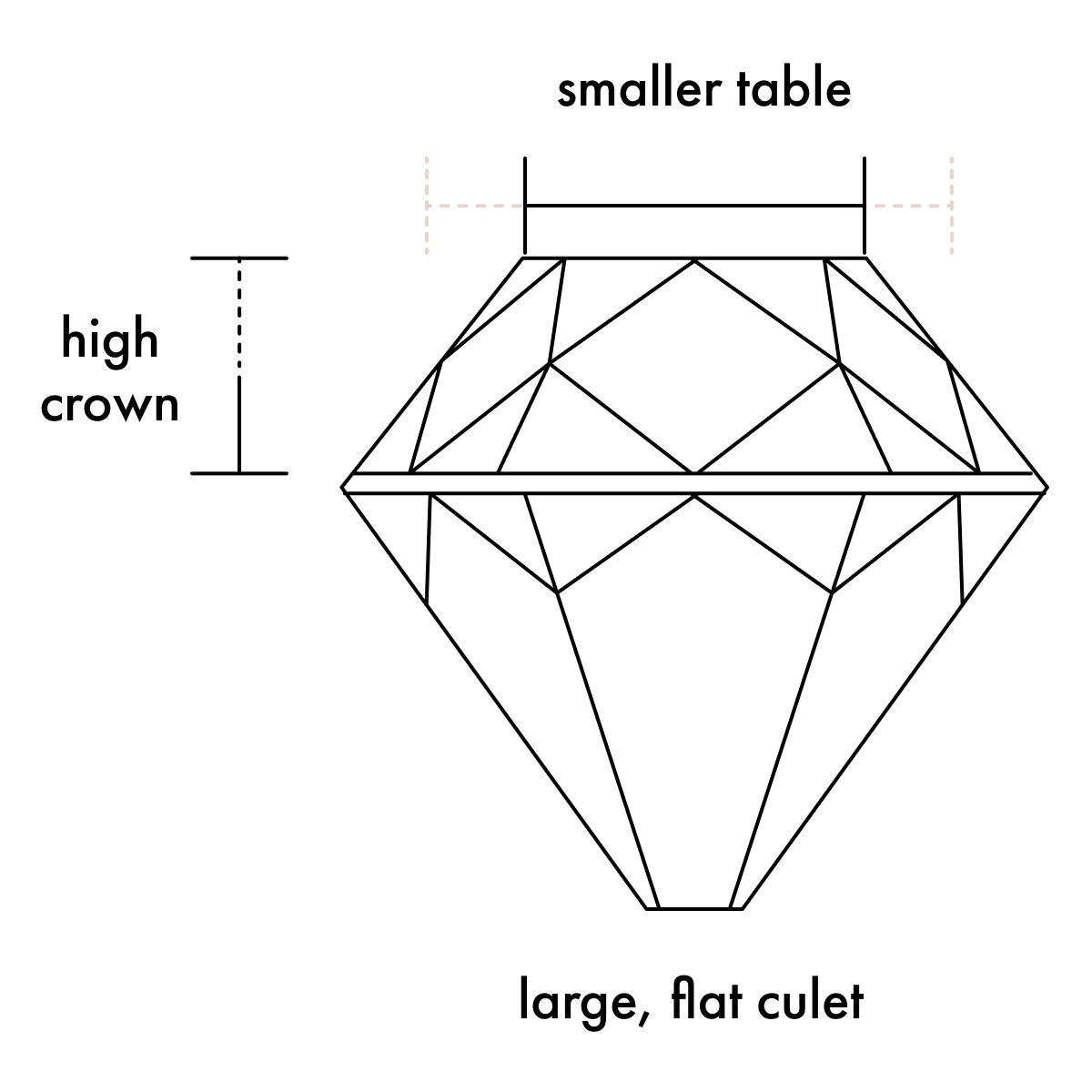
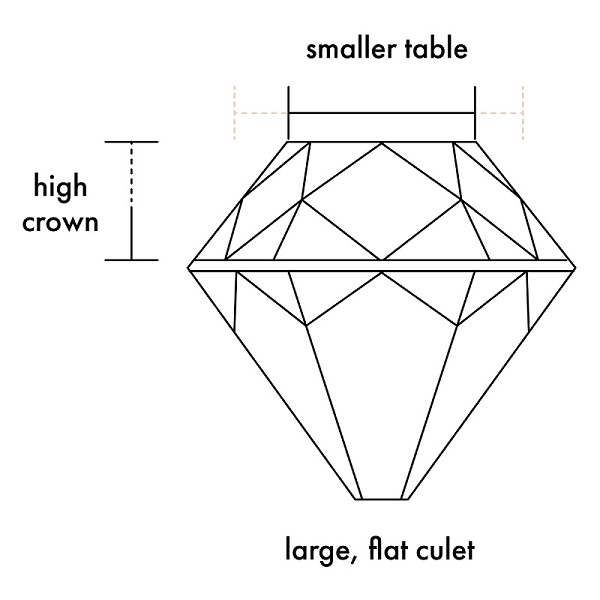
History of the Old Mine Cut Diamond
The term Old Mine cut was first used in the late 1800s despite the cut’s actual popularity starting in the early 1700s. It has also been called the “Old Miners Cut” and the “Miners Cut”. At the time,Old Mine specifically identified any colorless or near colorless diamonds hailing from Indian and Brazilian mines, as opposed to the newly discovered mines in Africa, whose production and output was gaining more and more prominence.
Subsequently, it came to indicate any diamond in that cut that had a high color grade, regardless of provenance, and eventually, it defined all diamonds that had a square-ish shape, a high crown, a small table, and a large culet.
Notable Diamond: The Grand Mazarin Diamond
The Grand Mazarin is a diamond with 17 crown and 17 pavilion facets that became its own cut. The shape, however, contains some visual similarities to what would then become the Old Mine diamond.
Cardinal Mazarin was the Chief Minister of France from 1642 to 1661 and was the de facto ruler when king Louis XIV was still a child. He accumulated a substantial diamond collection: he financed the trips to India of Jean-Baptiste Tavernier, a pioneer of the diamond trade. He bequeathed 18 diamond jewels to the Crown of France. Among these is the Grand Mazarin diamond, a 19.07-carat pink diamond.
It was extracted at Golconda. This part of the Indian plateau of Deccan is where some of the most visually remarkable diamonds were unearthed. These include the Koh-I-Noor, the Regent, the Wittelsbach-Graff.
The Peruzzi Diamond
The Peruzzi diamond is a diamond that then set the standard for its own cut–the Peruzzi cut, and was created in the 17th century in Venice by Vincenzo Peruzzi. The Peruzzi diamond is credited for being the first diamond consisting of 57 facets, a table, and a culet. It is a square-ish diamond with a small rectangular notch in the top left or right corner. Note that one of the corners has a small cut-out, which ensures that if the diamond falls on its corner, it won't break easily. Given its square-ish shape and the numbers of facets, it can be considered a precursor to the Old Mine diamond.
Be the first to know
Hear about our latest designs and upcoming events.
What Is the Difference Between Old European and Old Mine Diamond?
It’s easy to confuse the Old Mine Cut with the Old European diamond. The easiest way to tell them apart is to compare their two diagrams. In the case of the Old Mine cut, it has a square-ish shape, a small table but large diamond-shaped facets on the crown, and large facets on the pavilion coupled with a large culet.
The Old European cut is round in shape, and its facets (including the culet) are smaller and more symmetrical than the one found in the Old Mine diamonds.
Both shapes have a greater total depth compared to modern Round Brilliant diamonds.
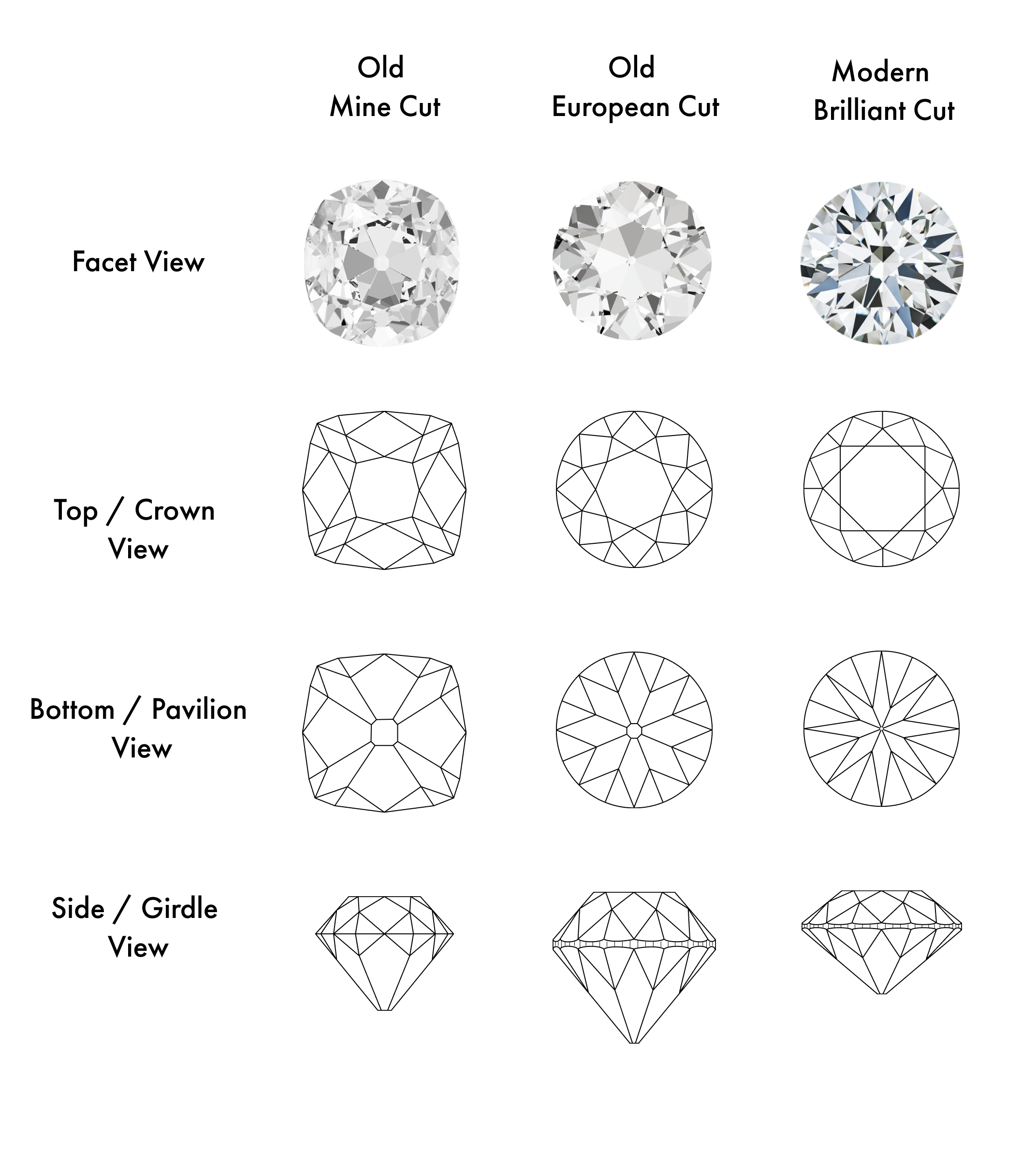
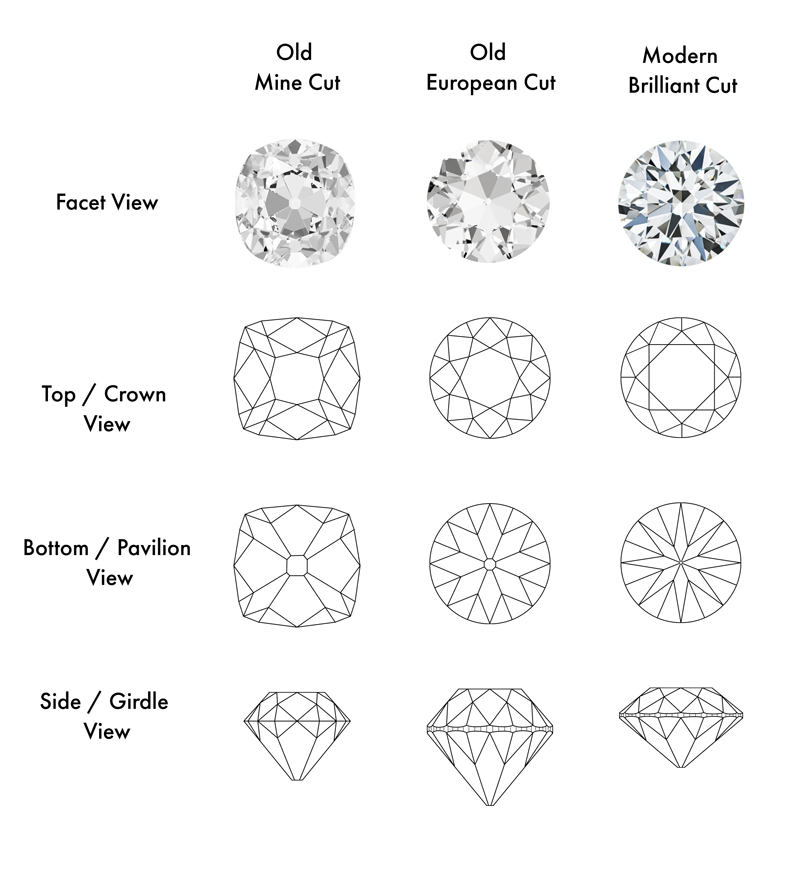
How Does an Old Mine Cut Diamond Compare to Modern Shapes?
The Old Mine Cut is a historical cut that was the basis of the Cushion cut due to its rounded corners and square-ish shape. It bears some similarities with the Round Brilliant Cut too, even though the Old Mine cut is square-ish in shape rather than round.
Old Mine Cut vs Round Brilliant Diamond
The Round and the Old Mine Cut diamond share the same number of facets (57-58) and have a similar faceting pattern, as both are considered Brilliant cutsen. That’s where the similarities end. The Old Mine diamond has a square shape, the Round Brilliant is round and symmetrical. The Old Mine Cut has a much higher crown and a deeper pavilion compared to the Round Brilliant cut. The proportions and depth of the Old Mine cut were optimized for the diamond to shimmer under candlelight, while the facets of the Round diamond were designed for maximum scintillation under electric light. In addition, the facets are larger, and rougher-cut than the ones in modern Round Brilliant diamonds, which creates more fire and more noticeable flashes of rainbow-colored brilliance.
Old Mine Cut: the Antique Cushion Cut
The Cushion Cut is considered the contemporary version of the Old Mine Cut. They share the square-ish shape and the brilliant-cut facets. “Cushions are the modern diamond with the most variance in their faceting pattern, which harkens back to both Old European and Old Mine Cut since those were cut individually by hand and could vary drastically from stone to stone and cutter to cutter,” says Grace Taylor, VRAI’s Senior Director of Sales and Customer Experience.
Old Mine Cut Diamonds and the 4Cs
Old Mine cuts have larger facets that maximize fire, similar to the modern Cushion diamond. The large facets of this diamond shape, however, make both inclusions and colors more visible especially at higher carat weights. “Old Mine Cuts are going to be less brilliant than modern diamonds because of the chunkier facets and higher crowns,” warns Grace Taylor. “They work particularly well in warmer colors, because antique Old Mine Cuts just tended to have more visible warmth and we now associate that with vintage charm.”
By today’s standards diamonds might have a lower cut grade but that’s not a defect of the stone itself. Old Mine diamonds were hand-cut and polished prior to the invention of refined mechanical tools, so they have a hand-cut feel that may look less precise and sharp than what we’re used to in contemporary stone cutting.
Are there lab-grown Old Mine Cut diamonds?
Lab grown diamonds cut in the Old Mine shape are quite hard to find, even though a thorough search can yield some results. They’re often called “Old Mine Cushion” or “Antique Cushion” cut. In the case of VRAI created diamonds, Taylor recommends the Elongated Cushion shape. Each Elongated Cushion has different proportions and length-to-width ratios, coupled with the intense fire cast by the larger facets. All of these characteristics reproduce the hand-cut feel of Old Mine diamonds.
Best Settings for Old Mine Diamond Engagement Rings
Old Mine diamonds work with engagement ring settings that emphasize their fire and their vintage-inspired feel. The Three Stone setting with Baguette side stones frames the Old Mine Cut’s unique faceting in an elegant way. The Floating Split Band is reminiscent of designs popular in the Georgian and Victorian era, so it naturally suits an Old Mine Cut diamond. The Classic Two Tone setting is vintage-inspired too as having prongs and shank in different colors was typical of 19th and early 20th century jewelry design.
What Is a VRAI Created Diamond?
A VRAI created diamond is a lab grown diamond created in a foundry that is Carbon Neutral certified as zero-emissions then cut and polished by master craftspeople. This means all VRAI created diamonds result from no mining, no human toll, no emissions. VRAI’s lab created diamonds are chemically, physically, and optically identical to mined diamonds. This means you can get more carats for less.

